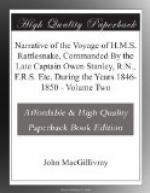About the end of 1848, an old Kowrarega man went by himself in a small canoe to the neighbourhood of Cape Cornwall, while the men of the tribe were absent turtling at the eastern end of Endeavour Strait. He was watched by a party of Gomokudin blacks or Yigeiles, who, guided by his fire, surprised and speared him. Immediately returning to the mainland, the perpetrators of this savage deed made a great fire by way of exultation. Meanwhile the turtling party returned, and when it became known that the old man had been missing for several days, they were induced by his two sons to search for him, and found the body horribly mutilated, with many spears stuck into it to show who had been the murderers. This explained the fire, so another was lit in reply to the challenge, and at night a party of Kowraregas in six canoes, containing all the men and lads of the tribe, crossed over to the main. They came upon a small camp of Yigeiles who had not been at all concerned in the murder, and enticed one of them to come out of the thicket where he had concealed himself by the offer of a fillet of cassowary feathers for information regarding the real murderers. As soon as the man stepped out, he was shot down with an arrow, his head cut off, and pursuit made after the rest. Towards morning their second camping-place was discovered and surrounded, when three men, one woman, and a girl were butchered. The heads of the victims were cut off with the hupi, or bamboo knife, and secured by the sringi, or cane loop, both of which are carried slung on the back by the Torres Strait islanders and the New Guinea men of the adjacent shores, when on a marauding excursion;* these Papuans preserve the skulls of their enemies as trophies, while the Australian tribes merely mutilate the bodies of the slain, and leave them where they fall.
(Footnote. See Jukes’ Voyage of the Fly Volume 1 page 277.)
Cannibalism.
The Kowraregas returned to their island with much exultation, announcing their approach by great shouting and blowing on conchs. The heads were placed on an oven and partially cooked, when the eyes were scooped out and eaten with portions of flesh cut from the cheek;* only those, however, who had been present at the murder were allowed to partake of this; the morsel was supposed to make them more brave. A dance was then commenced, during which the heads were kicked along the ground, and the savage excitement of the dancers almost amounted to frenzy. The skulls were ultimately hung up on two cross sticks near the camp, and allowed to remain there undisturbed.
(Footnote. The eyes and cheeks of the survivors from the wreck of a Charles Eaton (in August 1834) were eaten by their murderers—a party consisting of different tribes from the eastern part of Torres Strait. See Nautical Magazine 1837 page 799.)




